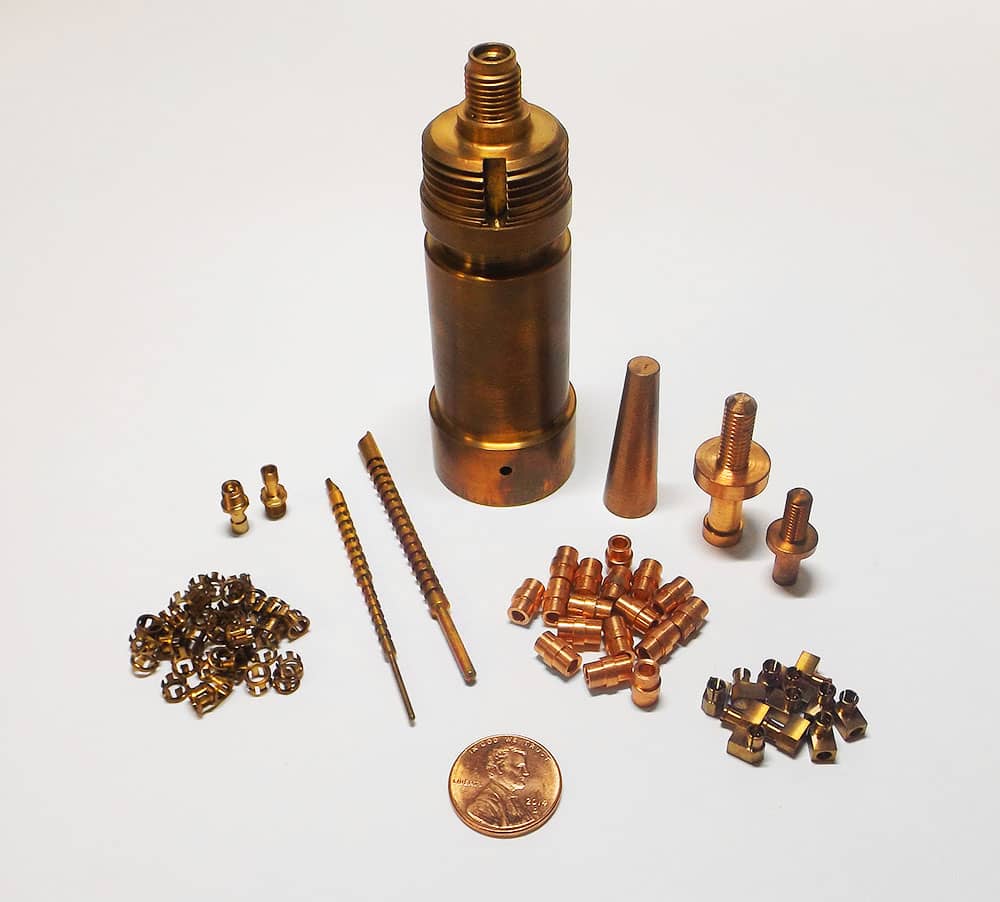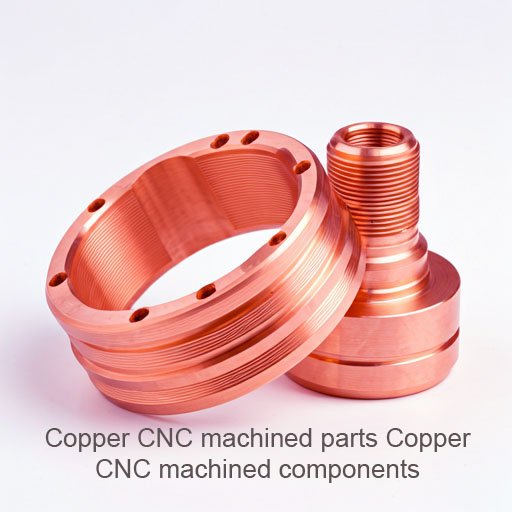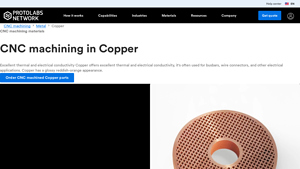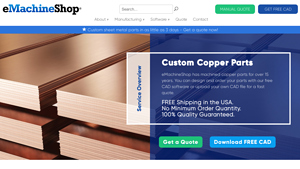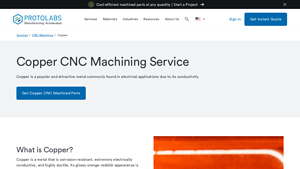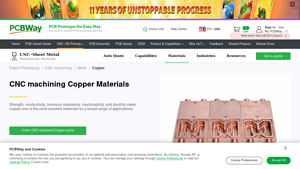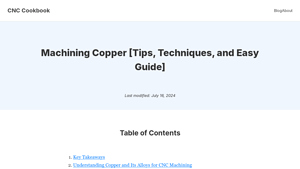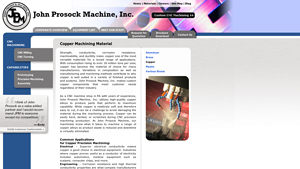Machined Copper Guide: Type, Cost, Top List…
Introduction: Navigating the Global Market for machined copper
In an increasingly interconnected global market, sourcing high-quality machined copper components presents a significant challenge for B2B buyers. The demand for copper, renowned for its exceptional electrical and thermal conductivity, continues to rise across various industries, from electrical engineering to construction and automotive. However, the complexities of international supply chains, coupled with varying quality standards and supplier reliability, can complicate the procurement process. This guide aims to demystify the landscape of machined copper, providing valuable insights into types of copper alloys, their applications, and best practices for supplier vetting.
Within these pages, you will discover detailed information on the most commonly used copper alloys, such as C110 and C101, along with their specific properties and applications. We will explore cost factors influencing machined copper components, including production methods and post-processing options that enhance performance and aesthetics. Additionally, this guide will equip international B2B buyers, particularly those in Africa, South America, the Middle East, and Europe (including Brazil and Germany), with the knowledge needed to make informed purchasing decisions. By understanding the nuances of sourcing machined copper, you can streamline your procurement process, mitigate risks, and ensure that your projects are supported by reliable and high-quality materials.
Understanding machined copper Types and Variations
| Type Name | Key Distinguishing Features | Primary B2B Applications | Brief Pros & Cons for Buyers |
|---|---|---|---|
| Copper C110 | 99.90% copper purity, excellent electrical conductivity | Electrical connectors, busbars | Pros: High conductivity, good corrosion resistance. Cons: Moderate weldability. |
| Copper C101 | 99.99% copper purity, superior ductility and corrosion resistance | High-performance electrical components | Pros: Exceptional conductivity, very ductile. Cons: Higher cost due to purity. |
| Copper Alloys | Combinations with other metals for enhanced properties | HVAC systems, automotive parts | Pros: Tailored properties for specific applications. Cons: May require special machining considerations. |
| Decorative Copper | Aesthetic appeal with potential surface treatments | Architectural features, art pieces | Pros: Visually striking, versatile in design. Cons: Requires careful handling to maintain appearance. |
| Copper Heat Exchangers | Designed for optimal thermal transfer | Industrial cooling systems | Pros: Efficient heat transfer, durable. Cons: Can be heavy and expensive. |
What are the Characteristics of Copper C110?
Copper C110 is a widely used alloy, known for its 99.90% copper content, which grants it exceptional electrical and thermal conductivity. This makes it ideal for applications such as electrical connectors and busbars. B2B buyers should consider the moderate weldability of this alloy, which may impact assembly processes. Its good corrosion resistance further enhances its suitability for outdoor and industrial environments, making it a reliable choice for various electrical applications.
How Does Copper C101 Compare in Terms of Performance?
Copper C101 boasts an impressive 99.99% purity, providing superior ductility and corrosion resistance. This alloy is particularly favored in high-performance electrical components where conductivity is critical. B2B buyers should weigh the higher cost against the benefits of enhanced performance, especially in demanding applications. Its excellent mechanical properties ensure longevity and reliability in various industrial settings, making it a strong investment for companies focused on quality and performance.
What are the Benefits of Using Copper Alloys?
Copper alloys, which combine copper with other metals, offer tailored properties that enhance performance for specific applications. These alloys are commonly used in HVAC systems and automotive parts, where different mechanical and thermal properties are desired. When purchasing, B2B buyers should assess the specific requirements of their applications to select the most suitable alloy. While these materials can provide significant benefits, they may also require specialized machining techniques, which can affect production timelines and costs.
What Should Buyers Know About Decorative Copper?
Decorative copper is valued for its aesthetic appeal and versatility in design. Often used in architectural features and art pieces, it provides a visually striking element to any project. B2B buyers should consider the need for surface treatments to maintain appearance, as copper can develop a patina over time. While its beauty is undeniable, careful handling and maintenance are essential to preserve its visual quality, which could influence long-term project costs.
How Effective are Copper Heat Exchangers in Industrial Applications?
Copper heat exchangers are designed for optimal thermal transfer, making them essential in industrial cooling systems. Their efficiency in heat transfer and durability make them a preferred choice for many industries. B2B buyers should consider the potential weight and cost implications when selecting these components, as they can be more expensive than alternatives. However, the long-term savings associated with energy efficiency and reduced maintenance can justify the initial investment, making them a valuable addition to industrial operations.
Key Industrial Applications of machined copper
| Industry/Sector | Specific Application of machined copper | Value/Benefit for the Business | Key Sourcing Considerations for this Application |
|---|---|---|---|
| Electrical Engineering | Busbars and electrical connectors | High electrical conductivity enhances performance | Ensure compliance with international standards and regulations |
| HVAC Systems | Heat exchangers and radiator components | Efficient heat transfer reduces energy costs | Evaluate material quality and thermal conductivity specifications |
| Automotive | Electrical wiring and connectors | Reliability in performance under varying conditions | Consider certifications and testing for durability and safety |
| Consumer Electronics | Custom housings and components for devices | Aesthetically pleasing and functional designs | Assess machining precision and post-processing options |
| Construction | Decorative architectural elements | Enhances visual appeal and durability | Look for suppliers with experience in custom designs |
How is Machined Copper Utilized in Electrical Engineering?
In electrical engineering, machined copper is primarily used in the production of busbars and electrical connectors. These components require high electrical conductivity to minimize energy loss and ensure reliable performance in power distribution systems. International buyers should focus on sourcing copper that meets stringent electrical standards, as well as ensure that suppliers can provide materials with precise tolerances and high-quality finishes to prevent failures in critical applications.
What Role Does Machined Copper Play in HVAC Systems?
Machined copper is essential in HVAC systems, particularly in the fabrication of heat exchangers and radiator components. Its excellent thermal conductivity allows for efficient heat transfer, resulting in reduced energy consumption and improved system performance. Buyers in this sector should prioritize sourcing copper materials that are corrosion-resistant and capable of withstanding high temperatures, while also considering suppliers with a proven track record in delivering high-quality machined components.
How is Machined Copper Applied in the Automotive Industry?
In the automotive sector, machined copper is widely used for electrical wiring and connectors, which are crucial for vehicle performance and safety systems. The reliability of these components directly impacts the vehicle’s functionality, especially under varying environmental conditions. B2B buyers should look for suppliers that offer high-purity copper with excellent mechanical properties, along with certifications that ensure compliance with automotive industry standards.
What Benefits Does Machined Copper Provide in Consumer Electronics?
Machined copper finds significant applications in consumer electronics, where it is used for custom housings and internal components. The metal’s aesthetic appeal, combined with its excellent conductivity, makes it a preferred choice for manufacturers looking to enhance both the functionality and design of their products. Buyers should seek suppliers that offer advanced machining capabilities and a variety of surface finishing options to ensure that the final products meet both performance and aesthetic requirements.
How is Machined Copper Used in Construction?
In the construction industry, machined copper is often utilized for decorative architectural elements, such as roofing, facades, and fixtures. Its natural resistance to corrosion, along with its striking visual properties, enhances the overall aesthetic of buildings while ensuring durability. Buyers should evaluate suppliers based on their ability to deliver custom designs that not only meet architectural standards but also comply with local building codes and environmental regulations.
3 Common User Pain Points for ‘machined copper’ & Their Solutions
Scenario 1: Navigating Supply Chain Disruptions in Machined Copper Procurement
The Problem: B2B buyers in industries reliant on machined copper often face supply chain disruptions that lead to delays in production schedules. These disruptions can stem from geopolitical tensions, natural disasters, or raw material shortages. Buyers may find themselves scrambling to secure copper parts, risking project timelines and increasing costs. The unpredictability of supply can hinder the ability to maintain consistent inventory levels, impacting not only immediate projects but also long-term relationships with clients.
The Solution: To mitigate supply chain risks, B2B buyers should establish relationships with multiple suppliers across different regions. Diversifying the supply base helps ensure that if one supplier faces disruptions, alternatives are readily available. Additionally, utilizing local suppliers can minimize shipping delays. It’s crucial to conduct thorough due diligence on suppliers, assessing their reliability, production capabilities, and past performance. Buyers should also consider implementing just-in-time inventory practices to reduce excess stock while still having enough materials to meet demand. Engaging in strategic partnerships with suppliers for better forecasting and communication can further enhance resilience against future disruptions.
Scenario 2: Ensuring Quality and Precision in Machined Copper Components
The Problem: Quality control is a significant concern for B2B buyers when procuring machined copper parts. Variations in material quality, inconsistencies in machining processes, and lack of adherence to specifications can lead to defective components, resulting in costly rework or product failures. Buyers may struggle to find suppliers who consistently deliver high-quality parts that meet their rigorous standards, which can affect the overall reliability of their products.
The Solution: To ensure quality and precision, buyers should prioritize working with suppliers who implement stringent quality management systems, such as ISO 9001 certification. Requesting detailed documentation of the machining processes, including tolerances and quality assurance measures, can provide insights into the supplier’s capabilities. It’s also beneficial to conduct regular audits and inspections of the supplier’s facilities, especially when entering new partnerships. Additionally, utilizing advanced technologies such as CNC machines that offer high accuracy and repeatability can significantly enhance the precision of machined copper components. Buyers should also consider requesting samples before placing bulk orders to verify that the quality meets their expectations.
Scenario 3: Understanding the Technical Specifications for Machined Copper Parts
The Problem: B2B buyers often encounter difficulties in understanding the technical specifications related to machined copper, such as material grades, tolerances, and machining methods. This lack of clarity can lead to miscommunication with suppliers, resulting in incorrect orders or parts that do not meet application requirements. Furthermore, the technical jargon can be overwhelming, especially for buyers who may not have an engineering background.
The Solution: To bridge the knowledge gap, buyers should invest time in understanding the basics of copper alloys and their specific properties, such as conductivity and corrosion resistance. Engaging with suppliers to discuss technical specifications upfront can clarify any uncertainties. Buyers should also leverage resources like material datasheets and machining guides provided by suppliers to better comprehend the nuances of machined copper. Additionally, utilizing CAD software to create detailed designs can facilitate clearer communication of requirements. Collaborating with a knowledgeable engineering partner or consultant can also help buyers navigate complex specifications, ensuring that their orders align perfectly with their project needs.
Strategic Material Selection Guide for machined copper
What Are the Key Properties of Common Copper Alloys for Machining?
When selecting materials for machined copper components, understanding the properties and applications of different copper alloys is crucial. The two most common alloys used in CNC machining are Copper C110 (Cu-ETP) and Copper C101 (Cu-OFE).
Copper C110 (Cu-ETP) is known for its excellent electrical and thermal conductivity, making it ideal for electrical applications such as busbars and connectors. It typically has a purity of 99.90% and offers good corrosion resistance. However, its weldability is moderate, which may limit its use in certain applications. For international buyers, especially in regions like Europe and the Middle East, compliance with standards such as ASTM B152 and EN 1977 is essential to ensure quality and performance.
Copper C101 (Cu-OFE) is a higher purity alloy at 99.99%, which enhances its conductivity even further. This alloy is particularly favored in high-performance electrical applications due to its superior corrosion resistance and ductility. However, its higher cost compared to C110 may deter some buyers. For B2B buyers in Africa and South America, understanding local sourcing options and compliance with international standards is vital for ensuring consistent quality in production.
What Are the Pros and Cons of Using Machined Copper Alloys?
Both Copper C110 and C101 have distinct advantages and disadvantages.
Pros:
– Excellent Conductivity: Both alloys provide outstanding electrical and thermal conductivity, making them suitable for a wide range of applications.
– Corrosion Resistance: They exhibit good resistance to corrosion, which is essential for longevity in electrical and outdoor applications.
– Ductility: Both alloys can be easily machined and formed, allowing for complex geometries.
Cons:
– Cost: C101 is generally more expensive than C110, which could impact budget-sensitive projects.
– Weldability Issues: Both alloys have moderate to poor weldability, which may necessitate alternative joining methods.
– Manufacturing Complexity: Machining copper requires specialized tools and techniques, which can add to production time and costs.
How Do These Alloys Impact Specific Applications?
The choice of alloy can significantly affect the performance of the final product. For instance, C110 is often used in applications where high conductivity is essential, such as electrical connectors and busbars. In contrast, C101 is more suitable for high-end applications, such as aerospace components and high-frequency electronics, where maximum conductivity and corrosion resistance are critical.
For international buyers, understanding the specific media compatibility of these alloys is crucial. For example, C110 is often used in environments with exposure to moisture, while C101 may be preferred in applications that require exposure to harsh chemicals.
What Should International B2B Buyers Consider When Selecting Copper Alloys?
International buyers must consider compliance with local and international standards when sourcing machined copper components. For example, European buyers should be familiar with DIN and EN standards, while those in South America may need to adhere to local regulations. Additionally, understanding the supply chain dynamics, including lead times and shipping costs, is essential for effective project management.
Summary Table of Machined Copper Alloys
| Material | Typical Use Case for machined copper | Key Advantage | Key Disadvantage/Limitation | Relative Cost (Low/Med/High) |
|---|---|---|---|---|
| Copper C110 | Electrical connectors, busbars | Excellent electrical conductivity | Moderate weldability | Medium |
| Copper C101 | Aerospace components, high-frequency electronics | Superior corrosion resistance | Higher cost compared to C110 | High |
This guide provides a comprehensive overview of the strategic material selection for machined copper, emphasizing the importance of understanding the properties, advantages, and considerations relevant to international B2B buyers.
In-depth Look: Manufacturing Processes and Quality Assurance for machined copper
What Are the Key Stages in the Manufacturing Process of Machined Copper?
The manufacturing process of machined copper involves several critical stages that ensure the final product meets quality and performance standards. The main stages include material preparation, forming, assembly, and finishing. Each stage utilizes specific techniques tailored to the unique properties of copper.
How Is Material Prepared for Machining Copper?
The initial stage in the manufacturing process is material preparation. High-quality copper alloys, such as C110 and C101, are selected based on the intended application. These materials are sourced from reputable suppliers to ensure consistency in electrical and thermal conductivity, ductility, and corrosion resistance.
Once the material is selected, it undergoes cutting to create blanks or billets that will be further processed. The blanks are typically cut using saws or shears to achieve the required dimensions. This stage is crucial, as any defects introduced during material preparation can affect the entire machining process.
What Forming Techniques Are Commonly Used in Machining Copper?
Forming is the next stage, where the prepared material is shaped into the desired components. CNC (Computer Numerical Control) machining is the predominant technique used for machining copper. CNC machining allows for high precision and repeatability, making it suitable for complex designs.
There are several CNC machining methods employed, including milling, turning, and electrical discharge machining (EDM).
-
CNC Milling utilizes rotating cutters to remove material, enabling the creation of intricate shapes and features. It is particularly effective for parts requiring tight tolerances.
-
CNC Turning is used for cylindrical parts, where the material rotates against a cutting tool. This method is ideal for producing components like shafts and rods.
-
EDM is advantageous for making parts with intricate internal features and sharp corners, which are difficult to achieve through conventional machining.
How Are Machined Copper Parts Assembled?
In some applications, machined copper parts require assembly with other components. This stage may involve joining techniques such as soldering, welding, or mechanical fastening. It is vital to select joining methods that preserve the material properties of copper, particularly its conductivity.
Quality assurance checks should be integrated throughout the assembly process to ensure that the final product meets specifications and performance standards.
What Finishing Techniques Enhance Machined Copper Products?
Finishing is a crucial stage that enhances the aesthetic appeal and functional properties of machined copper parts. Common finishing techniques include polishing, anodizing, and plating.
-
Polishing improves surface smoothness and shine, which is particularly important for decorative applications.
-
Anodizing can provide a protective oxide layer that enhances corrosion resistance, although it’s less common for copper than for aluminum.
-
Plating may be used to apply a thin layer of another metal, which can improve wear resistance or alter the appearance of the copper.
What Quality Assurance Standards Are Relevant for Machined Copper?
Quality assurance is a critical aspect of the manufacturing process, ensuring that machined copper products meet international standards and customer expectations. Key quality standards include ISO 9001, which outlines the requirements for a quality management system, and industry-specific certifications like CE marking for electrical products and API standards for oil and gas applications.
What Are the Key Quality Control Checkpoints?
Quality control (QC) involves several checkpoints throughout the manufacturing process:
-
Incoming Quality Control (IQC) focuses on the inspection of raw materials before processing. It ensures that the copper alloys meet specified chemical and physical properties.
-
In-Process Quality Control (IPQC) occurs during the machining process, where operators monitor dimensions and tolerances to ensure compliance with design specifications. This can include the use of gauges and measurement tools.
-
Final Quality Control (FQC) is conducted on finished products to verify that they meet all relevant specifications. This stage often includes functional testing, dimensional checks, and visual inspections.
How Can B2B Buyers Verify Supplier Quality Control Practices?
For international B2B buyers, especially those from regions like Africa, South America, the Middle East, and Europe, verifying a supplier’s quality control practices is essential to mitigate risks associated with sourcing machined copper parts. Here are some actionable steps:
-
Conduct Audits: Regular audits of suppliers can provide insights into their manufacturing processes and quality assurance practices. This includes reviewing their quality management system and adherence to international standards.
-
Request Quality Assurance Reports: Suppliers should provide detailed documentation of their QC processes, including inspection reports, test results, and certifications. This transparency can help buyers assess the reliability of their supplier.
-
Utilize Third-Party Inspection Services: Engaging third-party inspectors can add an additional layer of assurance. These independent services can perform on-site inspections and testing to validate the quality of the products before shipment.
What Testing Methods Are Commonly Used for Machined Copper?
Various testing methods are employed to ensure the quality of machined copper parts. Common techniques include:
-
Mechanical Testing: This includes tensile tests to measure strength and ductility, as well as hardness tests to determine material resistance.
-
Electrical Testing: Given copper’s primary use in electrical applications, testing for electrical conductivity is crucial. This ensures that the parts meet performance requirements for their intended use.
-
Corrosion Testing: Evaluating the corrosion resistance of machined copper parts is essential, particularly for products exposed to harsh environments. Salt spray tests are commonly used to simulate long-term exposure.
Conclusion
The manufacturing processes and quality assurance practices for machined copper are intricate and essential for producing high-quality components. Understanding these processes, from material preparation to finishing, along with robust quality control measures, can empower B2B buyers to make informed decisions when sourcing machined copper parts. By verifying supplier practices and adhering to international standards, businesses can ensure that they receive reliable and high-performance products tailored to their specific needs.
Practical Sourcing Guide: A Step-by-Step Checklist for ‘machined copper’
In the competitive landscape of international B2B sourcing, procuring machined copper components requires careful planning and execution. This guide provides a practical checklist to help buyers navigate the complexities of sourcing machined copper, ensuring you find the right suppliers and achieve optimal results for your projects.
Step 1: Define Your Technical Specifications
Before starting the sourcing process, clearly outline your technical requirements for machined copper components. This includes defining dimensions, tolerances, surface finish, and material grade (e.g., Copper C110 or C101). Detailed specifications will facilitate accurate quotes and prevent misunderstandings with suppliers.
- Key Considerations:
- What are the dimensional constraints and tolerances required?
- Are there specific surface treatments or finishes needed for your application?
Step 2: Research Potential Suppliers
Conduct thorough research to identify potential suppliers who specialize in CNC machining of copper. Look for manufacturers with experience in your specific industry and region. Supplier capabilities can vary significantly, so ensuring they can meet your requirements is crucial.
- Where to Look:
- Online supplier directories and industry forums.
- Trade shows and exhibitions focused on machining and materials.
Step 3: Verify Supplier Certifications
It’s essential to confirm that potential suppliers hold relevant certifications that demonstrate their commitment to quality and industry standards. Look for certifications such as ISO 9001 for quality management and any specific certifications relevant to your industry.
- Why It Matters:
- Certifications provide assurance of the supplier’s adherence to quality processes.
- They can indicate the supplier’s capability to meet international standards, crucial for global sourcing.
Step 4: Request Samples and Prototype Parts
Before placing a bulk order, request samples or prototypes of the machined copper parts. This step allows you to evaluate the quality of the machining, material properties, and adherence to your specifications.
- What to Assess:
- Surface finish and overall aesthetics.
- Dimensional accuracy and functionality in your application.
Step 5: Evaluate Pricing and Terms
Gather quotes from multiple suppliers and compare their pricing structures. Pay attention to terms such as lead times, payment conditions, and minimum order quantities. Understanding the total cost, including shipping and customs, will help you make an informed decision.
- Considerations:
- Are there hidden costs, such as tooling or setup fees?
- How do lead times align with your project timelines?
Step 6: Assess Customer Support and Communication
Effective communication with your supplier is vital for a successful partnership. Evaluate their responsiveness and willingness to collaborate on design modifications or issues that may arise during production.
- Indicators of Good Support:
- Prompt replies to inquiries and clarity in communication.
- Availability of technical support for troubleshooting or design assistance.
Step 7: Establish a Quality Control Plan
Once you select a supplier, establish a quality control plan that outlines the criteria for acceptance of the machined copper parts. This should include inspection methods and frequency to ensure that the parts meet your specifications throughout the production run.
- Key Elements:
- Define quality benchmarks and testing methods.
- Ensure there is a clear process for addressing any quality issues that may arise.
By following this structured checklist, B2B buyers can streamline the sourcing process for machined copper, reducing risks and enhancing the likelihood of successful procurement outcomes.
Comprehensive Cost and Pricing Analysis for machined copper Sourcing
What Are the Key Cost Components in Machined Copper Sourcing?
Understanding the cost structure of machined copper is essential for international B2B buyers. The primary cost components include materials, labor, manufacturing overhead, tooling, quality control (QC), logistics, and supplier margins.
-
Materials: The choice of copper alloy significantly affects the cost. Common alloys such as Copper C110 and C101 vary in price due to their distinct properties and applications. C110, with 99.90% copper content, is generally less expensive than C101, which boasts 99.99% purity. Prices fluctuate based on market conditions, so monitoring copper prices can help in budgeting.
-
Labor: Labor costs depend on the complexity of the machining process. CNC machining requires skilled labor, and labor rates can vary widely based on geographic location. Regions with lower labor costs can offer competitive pricing, but the quality and expertise of the machinists should not be overlooked.
-
Manufacturing Overhead: This includes utilities, equipment maintenance, and factory operation costs. High-quality CNC machines capable of precision work often come with higher overhead costs, which can be passed on to buyers.
-
Tooling: Initial tooling costs can be substantial, especially for complex designs requiring specialized tools. However, these costs can be amortized over larger production runs, making them more manageable for high-volume orders.
-
Quality Control: Maintaining high standards through rigorous QC processes adds to the overall cost. Buyers should prioritize suppliers with certified quality management systems to ensure product consistency and reliability.
-
Logistics: Shipping costs can vary based on distance, mode of transport, and the terms of delivery (Incoterms). Understanding the logistics framework is crucial for international buyers, particularly in regions like Africa and South America, where infrastructure may impact delivery times and costs.
-
Margin: Suppliers typically add a margin to cover their costs and ensure profitability. This margin can vary based on market competition, supplier reputation, and the buyer’s negotiation skills.
How Do Price Influencers Impact Machined Copper Costs?
Several factors influence the pricing of machined copper, including order volume, specifications, material quality, and supplier dynamics.
-
Volume/MOQ: Suppliers often provide discounts for larger orders due to reduced handling costs. Minimum Order Quantities (MOQs) can also impact pricing—understanding these thresholds can help in negotiating better terms.
-
Specifications and Customization: Custom parts require additional time and resources, influencing the overall cost. Detailed specifications can lead to cost efficiencies, but be prepared for potential increases in the price for highly customized solutions.
-
Quality and Certifications: Higher quality standards and certifications can increase costs but are essential for industries where reliability is critical. Always verify the certifications of suppliers to ensure compliance with international standards.
-
Supplier Factors: The reputation and reliability of suppliers play a significant role in pricing. Established suppliers may charge a premium, but their consistency and quality assurance can mitigate risks.
-
Incoterms: Understanding Incoterms is vital for international transactions. Terms like FOB (Free on Board) or CIF (Cost, Insurance, and Freight) affect the overall cost structure and should be clearly defined in contracts.
What Buyer Tips Can Help Optimize Costs in Machined Copper Sourcing?
-
Negotiate: Strong negotiation skills can lead to better pricing. Engage multiple suppliers to leverage competitive pricing while ensuring quality remains a priority.
-
Focus on Cost-Efficiency: Always calculate the Total Cost of Ownership (TCO), which includes not just the purchase price but also the costs associated with quality control, logistics, and potential downtime due to inferior parts.
-
Understand Pricing Nuances for International Transactions: Different regions may have varying pricing structures due to local market conditions. Buyers from Africa, South America, the Middle East, and Europe should be aware of currency fluctuations, import duties, and shipping costs that can impact the final price.
-
Stay Informed on Market Trends: Keeping abreast of copper market trends and pricing will aid in timing purchases to optimize costs, especially for bulk orders.
Conclusion: What Should Buyers Keep in Mind?
While indicative prices can provide a starting point for budgeting, the actual costs will depend on the specific requirements and negotiations with suppliers. Being informed about the various cost components and pricing influencers will enable buyers to make strategic decisions that align with their sourcing goals.
Alternatives Analysis: Comparing machined copper With Other Solutions
When evaluating solutions for specific applications in manufacturing and electrical engineering, it’s essential to consider viable alternatives to machined copper. While copper is renowned for its excellent conductivity and machinability, other materials and methods may offer unique advantages depending on the project requirements. This analysis explores how machined copper compares to alternative materials like aluminum and 3D-printed plastics, as well as traditional casting methods.
| Comparison Aspect | Machined Copper | Aluminum Casting | 3D-Printed Plastics |
|---|---|---|---|
| Performance | High electrical and thermal conductivity, excellent corrosion resistance. | Good conductivity, lighter weight, decent corrosion resistance. | Limited conductivity, suitable for non-electrical applications. |
| Cost | Generally higher due to material and machining costs. | Lower material costs, but can vary with complexity. | Cost-effective for low-volume production and complex geometries. |
| Ease of Implementation | Requires CNC machining expertise and equipment. | Easier to implement for large parts; requires molds. | Straightforward, especially for rapid prototyping. |
| Maintenance | Durable and long-lasting; requires minimal maintenance. | Can corrode without proper coatings; requires periodic checks. | Less durable; may require replacement for wear and tear. |
| Best Use Case | Electrical components, heat exchangers, decorative applications. | Aerospace, automotive parts, structural applications. | Prototyping, low-volume custom parts in non-load-bearing applications. |
What Are the Advantages and Disadvantages of Aluminum Casting Compared to Machined Copper?
Aluminum casting is a popular alternative due to its lower material costs and lighter weight. It offers good corrosion resistance and is relatively easy to manufacture, especially for larger components. However, aluminum does not match the thermal and electrical conductivity of copper, making it less suitable for applications requiring high performance in these areas. Additionally, while aluminum can be molded into complex shapes, the initial setup for casting can be more time-consuming and costly due to the need for molds.
How Does 3D-Printed Plastic Compare to Machined Copper?
3D-printed plastics are increasingly used for rapid prototyping and producing complex geometries. They are cost-effective, especially for low-volume runs, and allow for swift iterations in design. However, their mechanical properties, including strength and durability, often fall short compared to machined copper. Moreover, plastics typically do not conduct electricity effectively, making them unsuitable for electrical applications. Thus, while 3D-printed plastics can excel in non-electrical components and decorative items, they lack the robustness required in high-performance settings.
What Are the Strengths and Weaknesses of Traditional Casting Methods Against Machined Copper?
Traditional casting methods can produce large quantities of parts at a lower cost per unit, making them an attractive option for mass production. They can handle complex designs and large component sizes efficiently. However, cast metals often have less precise tolerances than machined parts, which can lead to additional finishing work. Furthermore, while some casting methods can utilize copper alloys, the overall performance in terms of conductivity and durability may not match that of precision-machined copper components.
In conclusion, selecting the right solution requires a careful assessment of specific project needs. B2B buyers should consider factors such as performance requirements, budget constraints, and the complexity of the parts being produced. Machined copper shines in applications demanding high conductivity and durability, while alternatives like aluminum casting and 3D-printed plastics may be more suitable for different use cases. Ultimately, understanding the strengths and limitations of each option will enable informed decision-making that aligns with business goals.
Essential Technical Properties and Trade Terminology for machined copper
What Are the Key Technical Properties of Machined Copper?
Understanding the essential technical properties of machined copper is crucial for B2B buyers who require precision-engineered components. Here are some of the most critical specifications to consider:
1. Material Grades: What Are C101 and C110 Copper Alloys?
The most common copper alloys used in machining are C101 (99.99% pure copper) and C110 (99.90% pure copper). C101 offers superior electrical conductivity and is often used in high-performance electrical applications. In contrast, C110 is favored for its balance of conductivity and corrosion resistance, making it suitable for various industrial applications. Knowing the right alloy helps in selecting the appropriate material for specific applications, impacting performance and longevity.
2. Tolerances: How Do Precision Measurements Affect Production?
Tolerances in machining refer to the permissible limits of variation in a physical dimension. For machined copper parts, typical tolerances can range from ±0.005 inches (±0.125mm) to tighter specifications depending on the complexity of the part. Accurate tolerances are critical for ensuring that components fit together seamlessly in assembly, which is particularly important in industries like automotive and electronics.
3. Ultimate Tensile Strength (UTS): Why Is It Important?
Ultimate tensile strength (UTS) is the maximum stress that a material can withstand while being stretched or pulled before failing. For C101 copper, the UTS is approximately 41 ksi (283 MPa). High UTS values indicate that the material can endure significant loads without deforming, which is essential for applications requiring durability and reliability.
4. Electrical and Thermal Conductivity: What Are Their Implications?
Copper is renowned for its excellent electrical and thermal conductivity. C110 copper boasts conductivity ratings of around 101.5% IACS (International Annealed Copper Standard), making it an optimal choice for electrical connectors and heat exchangers. Understanding conductivity is vital for buyers in the electrical and energy sectors, as it directly affects the efficiency of their products.
5. Corrosion Resistance: How Does It Impact Longevity?
Copper exhibits good corrosion resistance, especially in environments that are not overly acidic or alkaline. This property is crucial for applications in construction and plumbing, where materials are exposed to moisture and other corrosive elements. Buyers should consider the environment in which their machined copper parts will be used to ensure longevity and performance.
What Are Common Trade Terms Related to Machined Copper?
Familiarity with industry jargon can facilitate smoother transactions and negotiations. Here are some key terms that B2B buyers should understand:
1. OEM (Original Equipment Manufacturer): What Does It Mean?
OEM refers to companies that produce parts or equipment that may be marketed by another manufacturer. In the context of machined copper, an OEM may source custom components to integrate into their products. Understanding OEM relationships helps buyers identify reliable suppliers who can meet specific quality and performance standards.
2. MOQ (Minimum Order Quantity): Why Is It Important?
Minimum Order Quantity (MOQ) is the smallest number of units that a supplier is willing to produce for a single order. Knowing the MOQ is crucial for budgeting and inventory management, especially for companies that may not require large volumes of machined copper parts.
3. RFQ (Request for Quotation): How Does It Work?
A Request for Quotation (RFQ) is a document that buyers send to suppliers to obtain pricing for specific quantities of parts or materials. An RFQ typically includes detailed specifications such as material grade, dimensions, and tolerances. Understanding how to create an effective RFQ can help buyers secure competitive pricing and better service.
4. Incoterms: What Are They and Why Do They Matter?
Incoterms (International Commercial Terms) are standardized trade terms that define the responsibilities of buyers and sellers in international transactions. They cover aspects such as shipping, insurance, and tariffs. Familiarity with Incoterms helps buyers navigate the complexities of global sourcing, ensuring that all parties understand their obligations.
5. CAD (Computer-Aided Design): How Does It Benefit Machining?
CAD refers to software used to create precision drawings or technical illustrations. In the context of machined copper, CAD files are essential for CNC machining processes, allowing manufacturers to produce parts with high accuracy. Buyers who provide CAD files can streamline the production process and ensure that their specifications are met.
By understanding these technical properties and trade terms, B2B buyers can make informed decisions when sourcing machined copper components, ultimately leading to improved product quality and operational efficiency.
Navigating Market Dynamics and Sourcing Trends in the machined copper Sector
What Are the Key Drivers and Trends in the Global Machined Copper Market?
The machined copper market is influenced by a variety of global drivers, including increasing demand for electrical components, advancements in manufacturing technology, and a growing focus on renewable energy solutions. Countries in Africa, South America, the Middle East, and Europe are witnessing a surge in infrastructure development, leading to heightened demand for copper in applications such as electrical wiring, connectors, and busbars. The rise of electric vehicles and renewable energy technologies, particularly solar and wind, is further propelling the need for high-quality copper components.
Emerging B2B trends include the adoption of advanced manufacturing technologies like CNC machining and automation, which enhance precision and reduce lead times. International buyers are increasingly leveraging digital platforms for sourcing machined copper parts, streamlining procurement processes and improving supply chain efficiency. Additionally, there is a trend towards customization, with companies seeking tailored solutions that meet specific operational requirements. The increasing integration of AI and machine learning in production processes is also enabling manufacturers to optimize performance and reduce costs, making copper sourcing more competitive.
How Can Sustainability and Ethical Sourcing Impact Machined Copper Procurement?
Sustainability is becoming a critical consideration in the sourcing of machined copper. The environmental impact of copper mining and processing is significant, with concerns over water usage, habitat destruction, and carbon emissions. As such, B2B buyers are placing greater emphasis on sourcing from suppliers who demonstrate commitment to sustainable practices. This includes utilizing recycled copper, which not only lessens the environmental footprint but also offers cost benefits.
Ethical supply chains are increasingly important, particularly in regions where mining practices have historically raised concerns about human rights and labor conditions. Buyers should seek suppliers who provide transparency in their sourcing processes and adhere to recognized ethical standards. Certifications such as ISO 14001 for environmental management and the Responsible Business Alliance (RBA) certification can serve as indicators of a supplier’s commitment to sustainable and ethical practices. By prioritizing suppliers with these certifications, international buyers can mitigate risks and enhance their brand reputation.
How Has the Machined Copper Sector Evolved Over Time?
The history of machined copper can be traced back thousands of years, with copper being one of the first metals used by humans. Initially, it was used for tools and decorative items due to its malleability and resistance to corrosion. The industrial revolution marked a significant turning point, as the demand for electrical applications surged, leading to innovations in copper processing techniques.
In the late 20th century, the introduction of CNC machining transformed the sector, allowing for high-precision fabrication of complex parts. This technological evolution has enabled manufacturers to meet the growing needs of various industries, from electronics to automotive, while maintaining the high standards required for modern applications. Today, the machined copper sector continues to adapt, embracing new technologies and sustainable practices to address the challenges of a rapidly changing global market.
Frequently Asked Questions (FAQs) for B2B Buyers of machined copper
-
How do I solve issues with the quality of machined copper parts?
To address quality concerns with machined copper components, it’s crucial to establish clear specifications before production. Work closely with your supplier to define tolerances, surface finishes, and material grades. Request samples or prototypes to assess quality before committing to larger orders. Additionally, implement a quality assurance process that includes third-party inspections, if necessary, particularly for international shipments. This proactive approach helps ensure that the parts meet your standards and reduces the risk of costly reworks. -
What is the best copper alloy for electrical applications?
For electrical applications, Copper C101 (99.99% pure) is often the best choice due to its superior electrical conductivity and resistance to corrosion. This alloy is ideal for components such as connectors and busbars, where high performance is essential. Copper C110 (99.90% pure) is another excellent option, offering good conductivity and mechanical properties. When selecting an alloy, consider the specific requirements of your application, including environmental factors and mechanical stress. -
What customization options are available for machined copper parts?
Machined copper parts can be customized in several ways, including size, shape, and surface finish. Most suppliers offer services like CNC milling, turning, and secondary operations such as anodizing or polishing. You can often specify tolerances and wall thicknesses based on your project needs. Additionally, many manufacturers utilize CAD software to accommodate unique designs, allowing for intricate geometries and precision machining tailored to specific applications. -
What are the typical minimum order quantities (MOQs) for machined copper parts?
Minimum order quantities for machined copper parts vary by supplier and the complexity of the part. Some manufacturers offer flexible MOQs, especially for prototype runs, allowing you to order as few as one or two units. For larger production runs, MOQs can range from 50 to several hundred pieces, depending on the machining process and material costs. Always clarify MOQs during negotiations to align your purchasing strategy with your production needs. -
What payment terms should I expect when sourcing machined copper?
Payment terms can vary significantly among suppliers and regions. Common practices include upfront deposits (ranging from 30-50%) with the balance due upon delivery or after inspection. Some suppliers may offer net 30 or net 60 terms for established buyers. It’s essential to discuss and agree on payment terms before placing an order to ensure clarity and avoid misunderstandings, especially in international transactions where currency exchange and transfer fees may apply. -
How do I vet suppliers for machined copper parts?
Vetting suppliers involves evaluating their capabilities, quality control processes, and industry reputation. Start by checking their certifications (e.g., ISO 9001) and customer reviews. Request case studies or references from previous clients to gauge their experience with similar projects. Additionally, consider visiting the supplier’s facility if feasible, or arrange virtual tours to assess their machinery and production processes. Establishing clear communication and responsiveness during this phase can also indicate the supplier’s reliability. -
What logistics considerations should I keep in mind when importing machined copper?
When importing machined copper, consider shipping costs, lead times, and customs regulations. It’s crucial to work with logistics providers experienced in international trade to ensure compliance with import/export laws. Additionally, factor in potential tariffs and duties that may apply to copper products in your destination country. Coordinate closely with your supplier regarding packaging and documentation to streamline the customs clearance process and avoid delays. -
How can I ensure timely delivery of my machined copper parts?
To ensure timely delivery, establish a clear timeline with your supplier from the outset, outlining production and shipping schedules. Regularly communicate with your supplier during the manufacturing process to track progress and address any potential delays early. Opt for suppliers with robust logistics capabilities and consider using expedited shipping options if time-sensitive. Additionally, having a buffer in your inventory can help mitigate risks associated with unforeseen delays in production or shipping.
Important Disclaimer & Terms of Use
⚠️ Important Disclaimer
The information provided in this guide, including content regarding manufacturers, technical specifications, and market analysis, is for informational and educational purposes only. It does not constitute professional procurement advice, financial advice, or legal advice.
While we have made every effort to ensure the accuracy and timeliness of the information, we are not responsible for any errors, omissions, or outdated information. Market conditions, company details, and technical standards are subject to change.
B2B buyers must conduct their own independent and thorough due diligence before making any purchasing decisions. This includes contacting suppliers directly, verifying certifications, requesting samples, and seeking professional consultation. The risk of relying on any information in this guide is borne solely by the reader.
Top 6 Machined Copper Manufacturers & Suppliers List
1. Hubs – Copper CNC Machining Services
Domain: hubs.com
Registered: 1998 (27 years)
Introduction: Copper CNC machining service for custom parts, available in Copper C110 (99.90% pure) and Copper C101 (99.99% pure). Excellent thermal and electrical conductivity, corrosion resistance, and mechanical properties. Capabilities include 3-axis and 5-axis CNC milling. Lead time is less than 10 days, with wall thickness of 0.75 mm and tolerances of ±0.125mm (±0.005″). Max part size is 200 x 80 x 100 cm…
2. eMachineShop – Custom Copper Parts
Domain: emachineshop.com
Registered: 1999 (26 years)
Introduction: Custom Copper Parts
– Machining Experience: Over 15 years
– Design Options: Free CAD software or upload your own CAD file
– Shipping: FREE in the USA
– Minimum Order Quantity: None
– Quality Guarantee: 100% Quality Guaranteed
– Material Characteristics: Non-magnetic, brownish-red color, ductile, easily machined, highly resistant to corrosion, excellent conductor of heat and electricity.
– Applicat…
3. Protolabs – Copper CNC Machining Service
Domain: protolabs.com
Registered: 2006 (19 years)
Introduction: Copper CNC Machining Service offers cost-efficient machined parts in any quantity. Key product details include: 1. **Material Types**: – Copper 101: 99.99% pure copper alloy with excellent electrical and thermal conductivity, high corrosion resistance, ductility, and impact strength. – Copper 110: 99.90% copper alloy used in electrical applications due to high thermal and electrical conductivity a…
4. PCBWay – CNC Machining in Copper
Domain: pcbway.com
Registered: 2012 (13 years)
Introduction: CNC machining in Copper offers high strength, excellent electrical and thermal conductivity, corrosion resistance, and good machinability. The service includes CNC Milling and CNC Turning processes for custom copper parts. Copper is suitable for a wide range of applications due to its ductility and deep drawing capabilities. Pricing and additional information can be obtained through a quote.
5. CNC Cookbook – Copper Machining Insights
Domain: cnccookbook.com
Registered: 2007 (18 years)
Introduction: Key Takeaways: Copper is valued for its machinability, ductility, impact strength, and corrosion resistance, with applications in electrical components and structural engineering. Alloys enhance these properties for high-speed machining. Efficient machining requires strategic design, appropriate tool selection (HSS and carbide), and optimization of parameters like feed rate and cutting speed. Adva…
6. John Prosock Machine, Inc. – Custom Copper Components
Domain: jprosock.com
Registered: 2003 (22 years)
Introduction: Copper is a versatile machining material known for its strength, conductivity, corrosion resistance, machinability, and ductility. It is widely used across various industries, with annual consumption exceeding 18 million tons. John Prosock Machine, Inc. specializes in custom copper components, utilizing high-quality copper alloys for precision machining. Key applications include electrical equipme…
Strategic Sourcing Conclusion and Outlook for machined copper
What Are the Key Takeaways for Strategic Sourcing of Machined Copper?
In today’s competitive landscape, strategic sourcing of machined copper is essential for businesses aiming to enhance operational efficiency and product quality. The material’s exceptional thermal and electrical conductivity, combined with its versatility across various industries—including electrical, construction, and consumer goods—positions it as a critical component in innovative manufacturing. By leveraging advanced CNC machining technologies, businesses can achieve high precision and repeatability, ensuring that even the most intricate designs are executed flawlessly.
How Can International Buyers Optimize Their Supply Chain for Machined Copper?
For international buyers, particularly from regions such as Africa, South America, the Middle East, and Europe, establishing reliable partnerships with manufacturers that offer both quality and competitive pricing is paramount. Engaging with suppliers who provide a range of copper alloys, like C110 and C101, can unlock opportunities for customized solutions tailored to specific application needs. As global demand for high-performance materials continues to rise, buyers are encouraged to take proactive steps in evaluating their sourcing strategies.
What Should You Do Next?
Embrace the future of manufacturing by exploring potential suppliers who can meet your unique specifications for machined copper. With the right sourcing strategy, your organization can not only improve product performance but also reduce lead times and costs. Now is the time to connect with trusted partners and capitalize on the advantages that machined copper offers, ensuring your business remains at the forefront of innovation.
